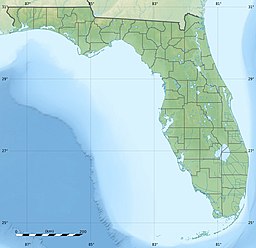Lake Osceola (Coral Gables)
| Lake Osceola | |
|---|---|
 Lake Osceola | |
| Location | University of Miami, Miami-Dade County, Florida |
| Coordinates | 25°43′06″N 80°16′45″W / 25.7184°N 80.2793°WCoordinates: 25°43′06″N 80°16′45″W / 25.7184°N 80.2793°W |
| Type | man-made lake |
Lake Osceola is a man-made, freshwater lake at the center of University of Miami's campus.[1]
History[]
Lake Osceola was initially built as a canal to connect Biscayne Bay and surrounding bodies of water but was later developed into a lake following the University of Miami's construction in the late 1940s.[1] Due to the lake's connection with Biscayne Bay and other natural bodies of water, wildlife began to inhabit following the initial migration of various species of fish and waterfowl.[1]
Prior to the completion of the lake's construction in 1947, Lake Osceola was given its name in 1929 by University of Miami's Iron Arrow Honor Society in honor of Seminole tribe leader and significant Floridian historical figure, Osceola.[2]
Death of Chad Meredith[]
Swimming in Lake Osceola is prohibited and punishable by expulsion by the University of Miami Office of Student Affairs in response to the death of a university student in 2001 from drowning. 18-year-old Miami student Chad Meredith passed away on the evening of November 4, 2001 while attempting to swim across the lake while intoxicated, accompanied by two of his fraternity brothers.[3] Police reports later cited Meredith's dangerously high blood alcohol content in conjunction with dropping water temperatures and exhaustion as the primary factors contributing to the incident, with the two fraternity members involved in the case charged with "negligence, breach of fiduciary duty, and breach of duty to aid and/or rescue."[3] The final settlement was considered one of the largest in the nation related to hazing-related fatalities, and the state of Florida later created the Chad Meredith Act, criminalizing hazing incidents at Florida high schools and universities.[3]
Ecosystem[]
Due to the lake's connection with Biscayne Bay, wildlife from the bay have continued to thrive in Lake Osceola's freshwater environment, including a number of fish, bird, and reptile species. While alligators and crocodiles are no longer present in Lake Osceola, manatees, turtles, ducks, ibis, snakes such as cottonmouths and multiple species of fish and bacteria continue to populate the lake.[1]
Environmental Concerns[]
Due to a number of contributing factors (notably fertilizer runoff), Lake Osceola began experiencing issues with stratification stemming from algae infestations in the lower strata of the lake, resulting in decreasing oxygen levels and the death of numerous species of fish that had inhabited the lake since its creation.[1] To combat decreasing oxygen levels and halt greater damage to the ecosystem, the university installed a fountain at the center of Lake Osceola to improve aeration and increase species diversification.[1]
References[]
- ^ a b c d e f Dominick and Barros, Molly and Sophie. "Lake Osceola a changing, complex landmark". The Miami Hurricane. The Miami Hurricane. Retrieved 15 February 2017.
- ^ Goodman, Allison. "The depths of Lake Osceola". The Miami Hurricane. The Miami Hurricane. Retrieved 5 December 2017.
- ^ a b c "Florida's Law on Hazing: The Chad Meredith Act", Florida State University, The Miami Hurricane, retrieved 5 December 2017
- Lakes of Florida
- Lakes of Miami-Dade County, Florida
